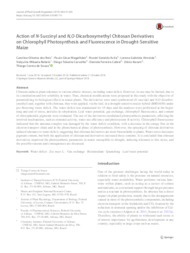Action of N-succinyl and N,O-dicarboxymethyl chitosan derivatives on chlorophyll photosynthesis and fluorescence in drought-sensitive maize.
Action of N-succinyl and N,O-dicarboxymethyl chitosan derivatives on chlorophyll photosynthesis and fluorescence in drought-sensitive maize.
Author(s): REIS, C. O. dos; MAGALHAES, P. C.; AVILA, R. G.; ALMEIDA, L. G.; RABELO, V. M.; CARVALHO, D. T.; CABRAL, D. F.; KARAM, D.; SOUZA, T. C. de
Summary: Chitosan induces plant tolerance to various abiotic stresses, including water deficit. However, its use may be limited, due to its constitution and low solubility in water. Thus, chemical modifications were proposed in this study with the objective of potentializing its biological effects in maize plants. The derivatives were semi-synthesized (N-succinyl and N,O-dicarboxymethyl) and, together with chitosan, they were applied, via the leaf, in a drought-sensitive maize hybrid (BRS1030) under pre-flowering water deficit. The water deficit was maintained for 15 days and the analyses were performed at the beginning and end of stress, and also in rehydration. Leaf water potential, gas exchange, chlorophyll fluorescence, and content of chloroplastidic pigments were evaluated. The use of the derivatives modulated photosynthesis parameters, affecting the involved mechanisms, such as stomatal activity, water use efficiency and photosystem II activity. Chlorophyll fluorescence indicated that the antenna complex was damaged by the water deficit condition, with a decrease in the energy flux in the electron transport chain and in the photochemical phase of photosynthesis. However, the spraying of chitosan derivatives induced tolerance to water deficit, suggesting that chitosan derivatives are more bioavailable to plants. Water stress decreases pigment content, but both the application of chitosan and derivatives increased these contents. It is concluded that chitosan derivatives improved the photosynthetic parameters in maize susceptible to drought, inducing tolerance to this stress, and the possible reasons and consequences are discussed.
Publication year: 2019
Types of publication: Journal article
Unit: Embrapa Maize & Sorghum
Keywords: Bioestimulante, Déficit hídrico, Milho, Potencial hídrico foliar, Trocas gasosas
Observation
Some of Embrapa's publications are published as ePub files. To read them, use or download one of the following free software options to your computer or mobile device. Android: Google Play Books; IOS: iBooks; Windows and Linux: Calibre.
Access other publications
Access the Agricultural Research Database (BDPA) to consult Embrapa's full library collection and records.
Visit Embrapa Bookstore to purchase books and other publications sold by Embrapa.

